Report on Accounting and Business Analysis for Sainsbury's Expansion
VerifiedAdded on 2020/02/03
|24
|6130
|68
Report
AI Summary
This report analyzes Sainsbury's expansion plan, focusing on accounting and business analysis techniques. The report is divided into five tasks. Task 1 focuses on the creation of a plan for the collection of primary and secondary data, choosing appropriate survey methods, sampling techniques, and questionnaires. Task 2 compares different formats of financial statements and their appropriateness for different types of businesses, and interprets and compares financial statements using appropriate ratios. Task 3 classifies different types of cost, uses different costing methods to calculate cost with suitable methods, and selects appropriate budgeting methods for an organization, preparing budgets. Task 4 analyzes budgets and makes appropriate decisions, calculates the unit cost and makes pricing decisions using relevant information, assesses the viability of a project using investment appraisal techniques, and analyzes sources of finance available to the business. The report uses data collected through questionnaires to determine the most beneficial pricing strategy and the role of investment appraisal techniques in reducing uncertainties. Overall, the report provides a detailed analysis of Sainsbury's expansion plans and the application of various accounting tools and techniques to support business decisions.
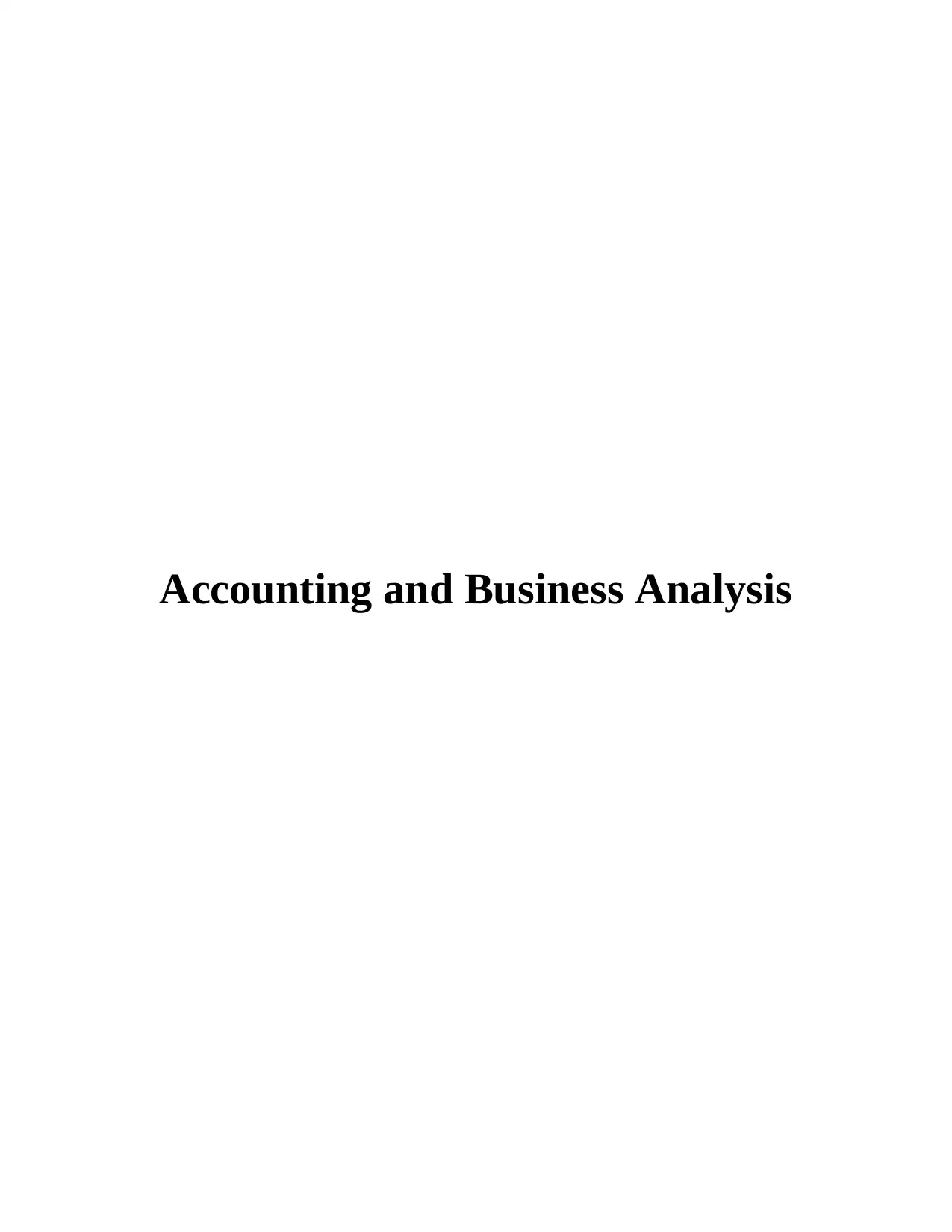
Accounting and Business Analysis
Paraphrase This Document
Need a fresh take? Get an instant paraphrase of this document with our AI Paraphraser
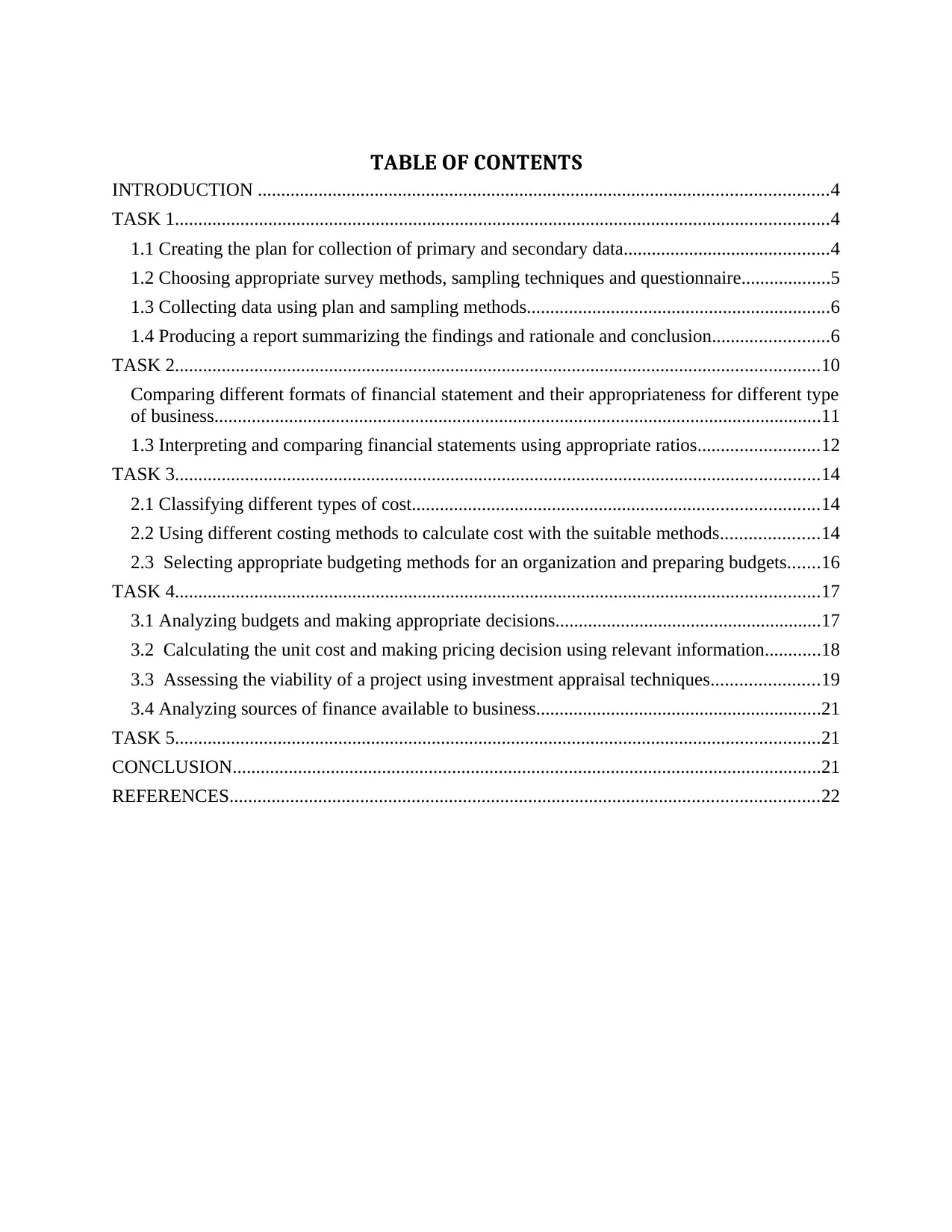
TABLE OF CONTENTS
INTRODUCTION ..........................................................................................................................4
TASK 1............................................................................................................................................4
1.1 Creating the plan for collection of primary and secondary data............................................4
1.2 Choosing appropriate survey methods, sampling techniques and questionnaire...................5
1.3 Collecting data using plan and sampling methods.................................................................6
1.4 Producing a report summarizing the findings and rationale and conclusion.........................6
TASK 2..........................................................................................................................................10
Comparing different formats of financial statement and their appropriateness for different type
of business..................................................................................................................................11
1.3 Interpreting and comparing financial statements using appropriate ratios..........................12
TASK 3..........................................................................................................................................14
2.1 Classifying different types of cost.......................................................................................14
2.2 Using different costing methods to calculate cost with the suitable methods.....................14
2.3 Selecting appropriate budgeting methods for an organization and preparing budgets.......16
TASK 4..........................................................................................................................................17
3.1 Analyzing budgets and making appropriate decisions.........................................................17
3.2 Calculating the unit cost and making pricing decision using relevant information............18
3.3 Assessing the viability of a project using investment appraisal techniques.......................19
3.4 Analyzing sources of finance available to business.............................................................21
TASK 5..........................................................................................................................................21
CONCLUSION..............................................................................................................................21
REFERENCES..............................................................................................................................22
INTRODUCTION ..........................................................................................................................4
TASK 1............................................................................................................................................4
1.1 Creating the plan for collection of primary and secondary data............................................4
1.2 Choosing appropriate survey methods, sampling techniques and questionnaire...................5
1.3 Collecting data using plan and sampling methods.................................................................6
1.4 Producing a report summarizing the findings and rationale and conclusion.........................6
TASK 2..........................................................................................................................................10
Comparing different formats of financial statement and their appropriateness for different type
of business..................................................................................................................................11
1.3 Interpreting and comparing financial statements using appropriate ratios..........................12
TASK 3..........................................................................................................................................14
2.1 Classifying different types of cost.......................................................................................14
2.2 Using different costing methods to calculate cost with the suitable methods.....................14
2.3 Selecting appropriate budgeting methods for an organization and preparing budgets.......16
TASK 4..........................................................................................................................................17
3.1 Analyzing budgets and making appropriate decisions.........................................................17
3.2 Calculating the unit cost and making pricing decision using relevant information............18
3.3 Assessing the viability of a project using investment appraisal techniques.......................19
3.4 Analyzing sources of finance available to business.............................................................21
TASK 5..........................................................................................................................................21
CONCLUSION..............................................................................................................................21
REFERENCES..............................................................................................................................22

⊘ This is a preview!⊘
Do you want full access?
Subscribe today to unlock all pages.

Trusted by 1+ million students worldwide
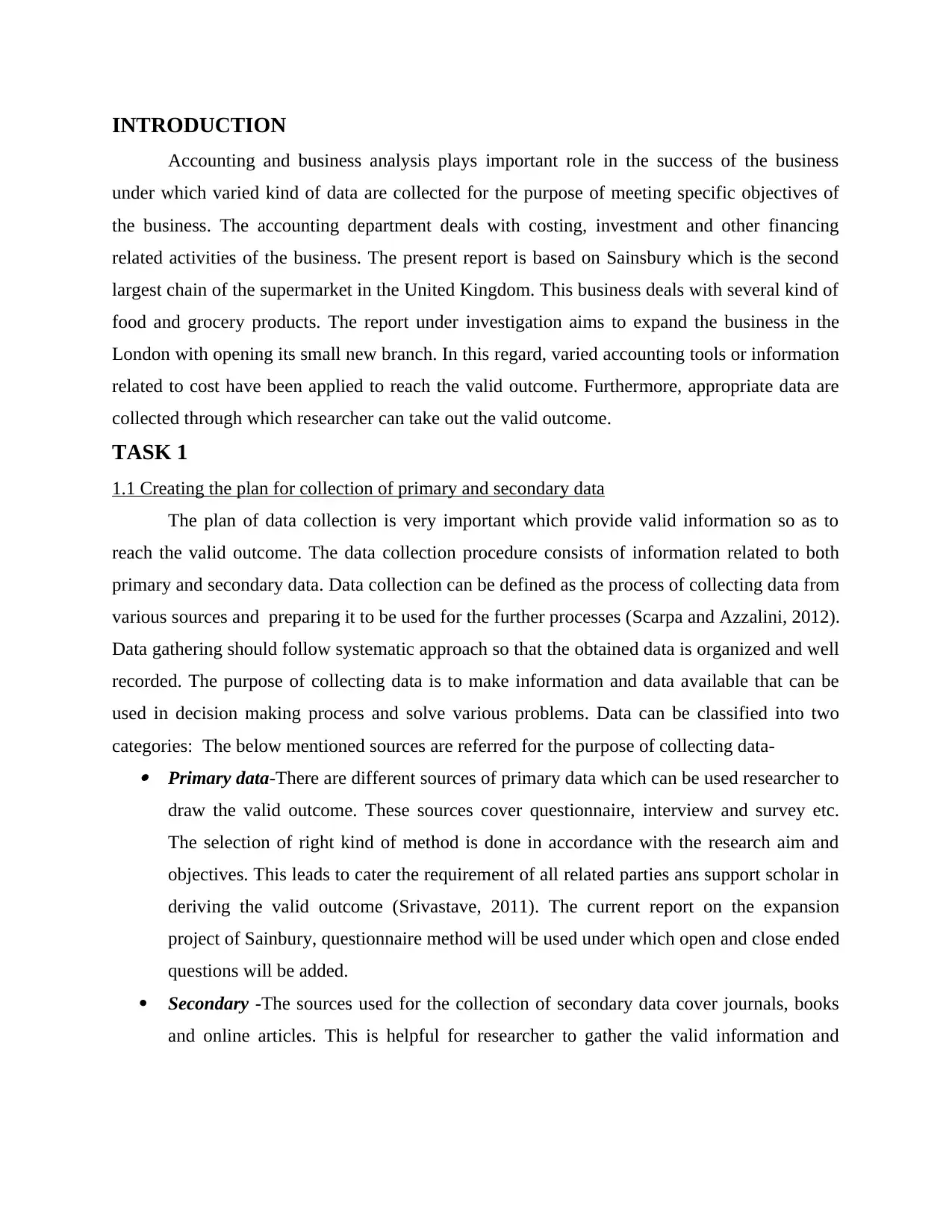
INTRODUCTION
Accounting and business analysis plays important role in the success of the business
under which varied kind of data are collected for the purpose of meeting specific objectives of
the business. The accounting department deals with costing, investment and other financing
related activities of the business. The present report is based on Sainsbury which is the second
largest chain of the supermarket in the United Kingdom. This business deals with several kind of
food and grocery products. The report under investigation aims to expand the business in the
London with opening its small new branch. In this regard, varied accounting tools or information
related to cost have been applied to reach the valid outcome. Furthermore, appropriate data are
collected through which researcher can take out the valid outcome.
TASK 1
1.1 Creating the plan for collection of primary and secondary data
The plan of data collection is very important which provide valid information so as to
reach the valid outcome. The data collection procedure consists of information related to both
primary and secondary data. Data collection can be defined as the process of collecting data from
various sources and preparing it to be used for the further processes (Scarpa and Azzalini, 2012).
Data gathering should follow systematic approach so that the obtained data is organized and well
recorded. The purpose of collecting data is to make information and data available that can be
used in decision making process and solve various problems. Data can be classified into two
categories: The below mentioned sources are referred for the purpose of collecting data- Primary data-There are different sources of primary data which can be used researcher to
draw the valid outcome. These sources cover questionnaire, interview and survey etc.
The selection of right kind of method is done in accordance with the research aim and
objectives. This leads to cater the requirement of all related parties ans support scholar in
deriving the valid outcome (Srivastave, 2011). The current report on the expansion
project of Sainbury, questionnaire method will be used under which open and close ended
questions will be added.
Secondary -The sources used for the collection of secondary data cover journals, books
and online articles. This is helpful for researcher to gather the valid information and
Accounting and business analysis plays important role in the success of the business
under which varied kind of data are collected for the purpose of meeting specific objectives of
the business. The accounting department deals with costing, investment and other financing
related activities of the business. The present report is based on Sainsbury which is the second
largest chain of the supermarket in the United Kingdom. This business deals with several kind of
food and grocery products. The report under investigation aims to expand the business in the
London with opening its small new branch. In this regard, varied accounting tools or information
related to cost have been applied to reach the valid outcome. Furthermore, appropriate data are
collected through which researcher can take out the valid outcome.
TASK 1
1.1 Creating the plan for collection of primary and secondary data
The plan of data collection is very important which provide valid information so as to
reach the valid outcome. The data collection procedure consists of information related to both
primary and secondary data. Data collection can be defined as the process of collecting data from
various sources and preparing it to be used for the further processes (Scarpa and Azzalini, 2012).
Data gathering should follow systematic approach so that the obtained data is organized and well
recorded. The purpose of collecting data is to make information and data available that can be
used in decision making process and solve various problems. Data can be classified into two
categories: The below mentioned sources are referred for the purpose of collecting data- Primary data-There are different sources of primary data which can be used researcher to
draw the valid outcome. These sources cover questionnaire, interview and survey etc.
The selection of right kind of method is done in accordance with the research aim and
objectives. This leads to cater the requirement of all related parties ans support scholar in
deriving the valid outcome (Srivastave, 2011). The current report on the expansion
project of Sainbury, questionnaire method will be used under which open and close ended
questions will be added.
Secondary -The sources used for the collection of secondary data cover journals, books
and online articles. This is helpful for researcher to gather the valid information and
Paraphrase This Document
Need a fresh take? Get an instant paraphrase of this document with our AI Paraphraser
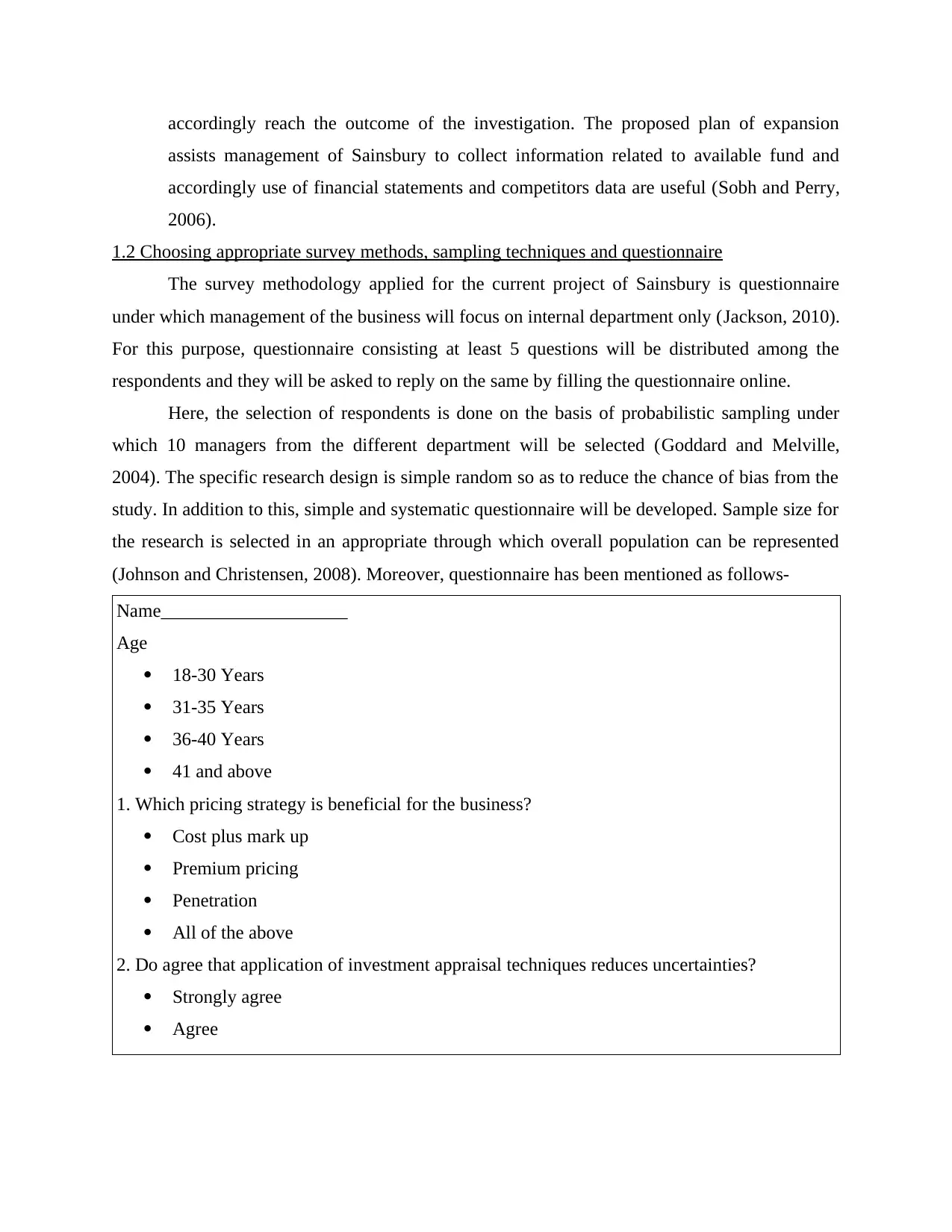
accordingly reach the outcome of the investigation. The proposed plan of expansion
assists management of Sainsbury to collect information related to available fund and
accordingly use of financial statements and competitors data are useful (Sobh and Perry,
2006).
1.2 Choosing appropriate survey methods, sampling techniques and questionnaire
The survey methodology applied for the current project of Sainsbury is questionnaire
under which management of the business will focus on internal department only (Jackson, 2010).
For this purpose, questionnaire consisting at least 5 questions will be distributed among the
respondents and they will be asked to reply on the same by filling the questionnaire online.
Here, the selection of respondents is done on the basis of probabilistic sampling under
which 10 managers from the different department will be selected (Goddard and Melville,
2004). The specific research design is simple random so as to reduce the chance of bias from the
study. In addition to this, simple and systematic questionnaire will be developed. Sample size for
the research is selected in an appropriate through which overall population can be represented
(Johnson and Christensen, 2008). Moreover, questionnaire has been mentioned as follows-
Name____________________
Age
18-30 Years
31-35 Years
36-40 Years
41 and above
1. Which pricing strategy is beneficial for the business?
Cost plus mark up
Premium pricing
Penetration
All of the above
2. Do agree that application of investment appraisal techniques reduces uncertainties?
Strongly agree
Agree
assists management of Sainsbury to collect information related to available fund and
accordingly use of financial statements and competitors data are useful (Sobh and Perry,
2006).
1.2 Choosing appropriate survey methods, sampling techniques and questionnaire
The survey methodology applied for the current project of Sainsbury is questionnaire
under which management of the business will focus on internal department only (Jackson, 2010).
For this purpose, questionnaire consisting at least 5 questions will be distributed among the
respondents and they will be asked to reply on the same by filling the questionnaire online.
Here, the selection of respondents is done on the basis of probabilistic sampling under
which 10 managers from the different department will be selected (Goddard and Melville,
2004). The specific research design is simple random so as to reduce the chance of bias from the
study. In addition to this, simple and systematic questionnaire will be developed. Sample size for
the research is selected in an appropriate through which overall population can be represented
(Johnson and Christensen, 2008). Moreover, questionnaire has been mentioned as follows-
Name____________________
Age
18-30 Years
31-35 Years
36-40 Years
41 and above
1. Which pricing strategy is beneficial for the business?
Cost plus mark up
Premium pricing
Penetration
All of the above
2. Do agree that application of investment appraisal techniques reduces uncertainties?
Strongly agree
Agree
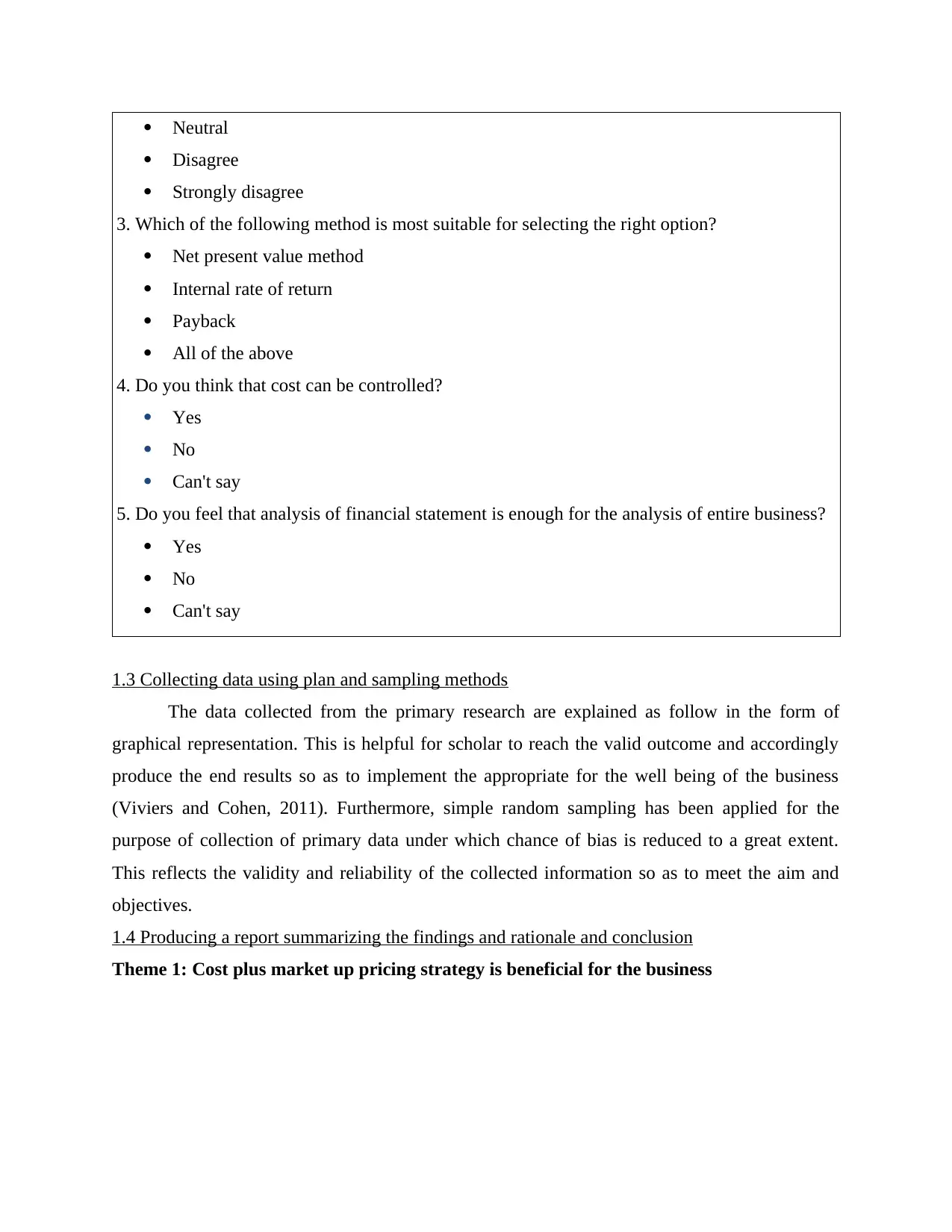
Neutral
Disagree
Strongly disagree
3. Which of the following method is most suitable for selecting the right option?
Net present value method
Internal rate of return
Payback
All of the above
4. Do you think that cost can be controlled?
Yes
No
Can't say
5. Do you feel that analysis of financial statement is enough for the analysis of entire business?
Yes
No
Can't say
1.3 Collecting data using plan and sampling methods
The data collected from the primary research are explained as follow in the form of
graphical representation. This is helpful for scholar to reach the valid outcome and accordingly
produce the end results so as to implement the appropriate for the well being of the business
(Viviers and Cohen, 2011). Furthermore, simple random sampling has been applied for the
purpose of collection of primary data under which chance of bias is reduced to a great extent.
This reflects the validity and reliability of the collected information so as to meet the aim and
objectives.
1.4 Producing a report summarizing the findings and rationale and conclusion
Theme 1: Cost plus market up pricing strategy is beneficial for the business
Disagree
Strongly disagree
3. Which of the following method is most suitable for selecting the right option?
Net present value method
Internal rate of return
Payback
All of the above
4. Do you think that cost can be controlled?
Yes
No
Can't say
5. Do you feel that analysis of financial statement is enough for the analysis of entire business?
Yes
No
Can't say
1.3 Collecting data using plan and sampling methods
The data collected from the primary research are explained as follow in the form of
graphical representation. This is helpful for scholar to reach the valid outcome and accordingly
produce the end results so as to implement the appropriate for the well being of the business
(Viviers and Cohen, 2011). Furthermore, simple random sampling has been applied for the
purpose of collection of primary data under which chance of bias is reduced to a great extent.
This reflects the validity and reliability of the collected information so as to meet the aim and
objectives.
1.4 Producing a report summarizing the findings and rationale and conclusion
Theme 1: Cost plus market up pricing strategy is beneficial for the business
⊘ This is a preview!⊘
Do you want full access?
Subscribe today to unlock all pages.

Trusted by 1+ million students worldwide
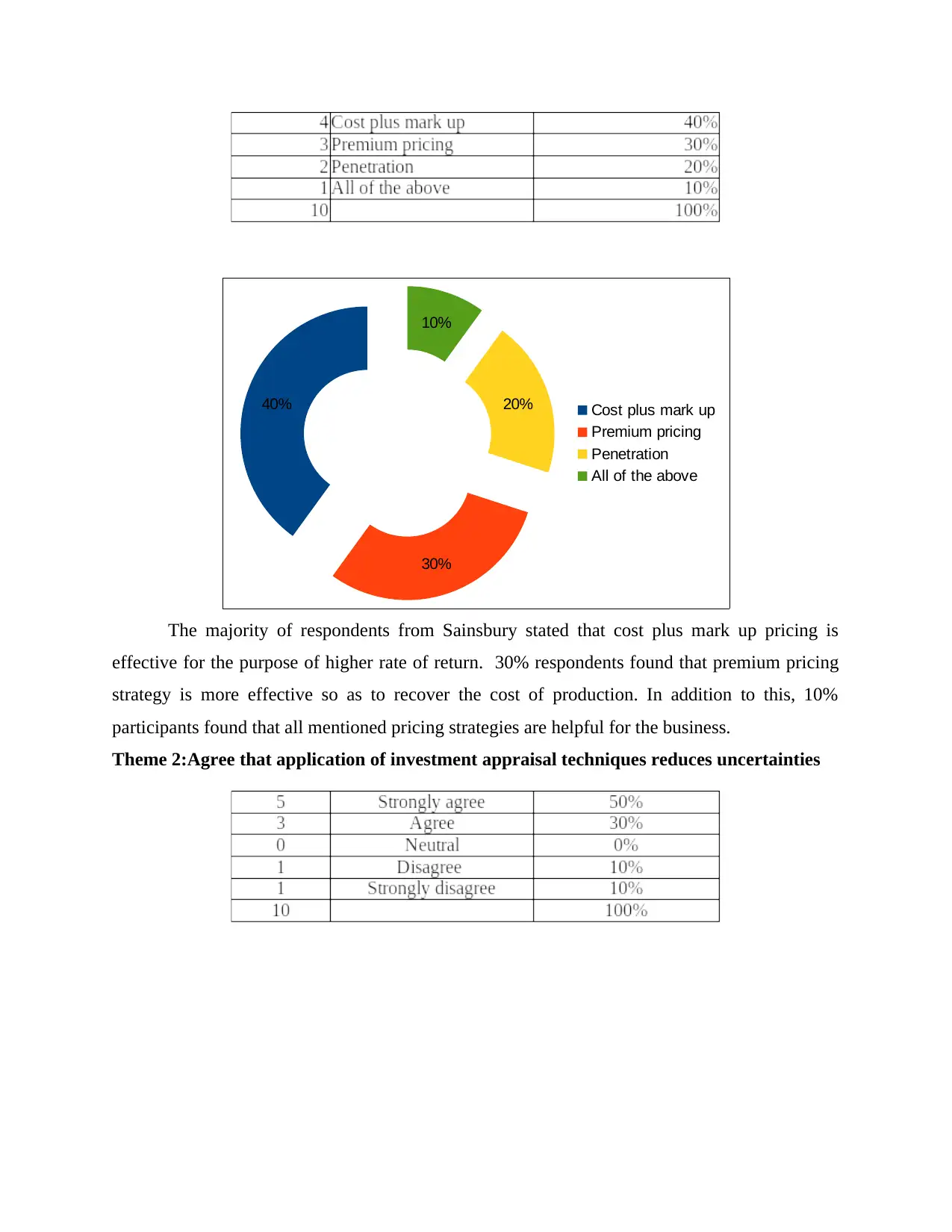
The majority of respondents from Sainsbury stated that cost plus mark up pricing is
effective for the purpose of higher rate of return. 30% respondents found that premium pricing
strategy is more effective so as to recover the cost of production. In addition to this, 10%
participants found that all mentioned pricing strategies are helpful for the business.
Theme 2:Agree that application of investment appraisal techniques reduces uncertainties
40%
30%
20%
10%
Cost plus mark up
Premium pricing
Penetration
All of the above
effective for the purpose of higher rate of return. 30% respondents found that premium pricing
strategy is more effective so as to recover the cost of production. In addition to this, 10%
participants found that all mentioned pricing strategies are helpful for the business.
Theme 2:Agree that application of investment appraisal techniques reduces uncertainties
40%
30%
20%
10%
Cost plus mark up
Premium pricing
Penetration
All of the above
Paraphrase This Document
Need a fresh take? Get an instant paraphrase of this document with our AI Paraphraser
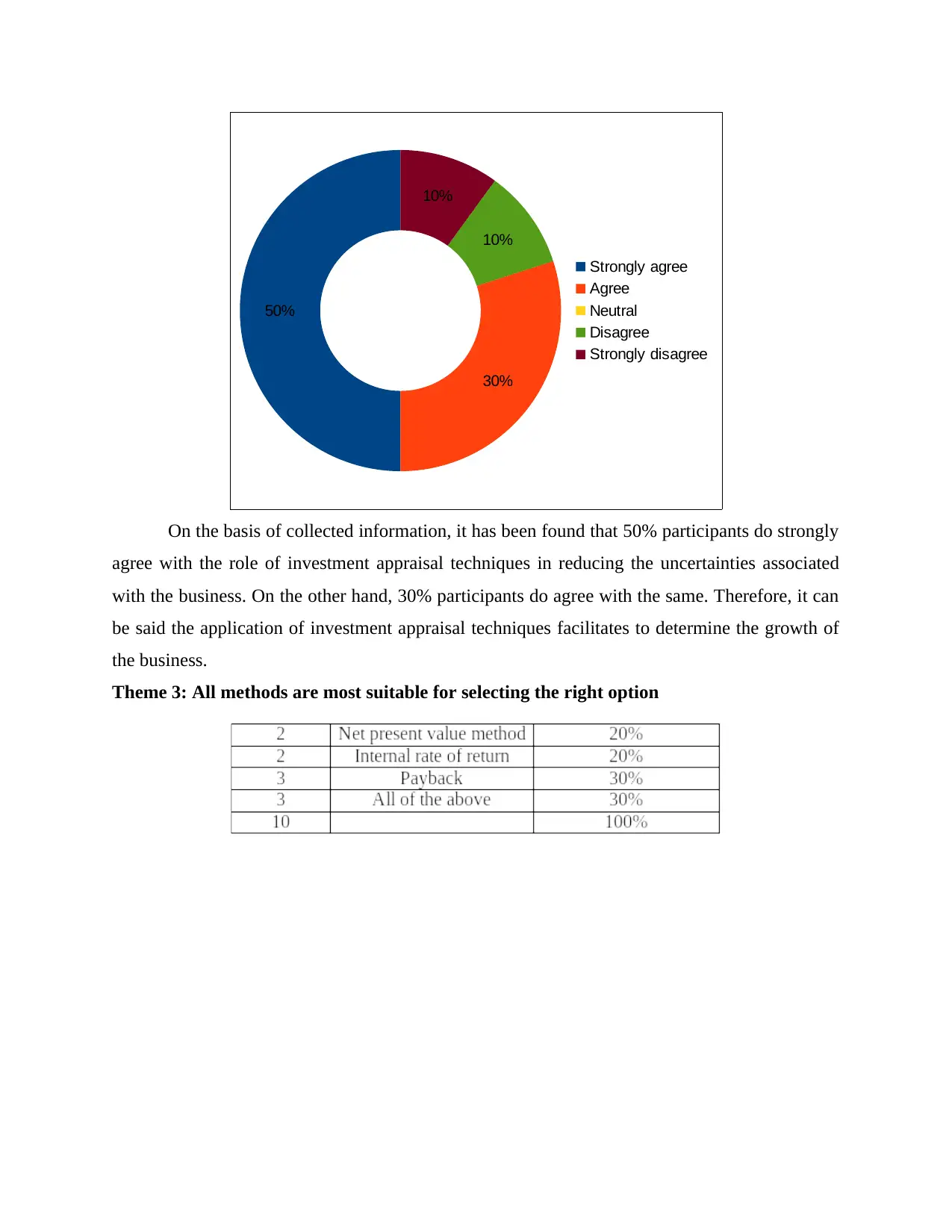
On the basis of collected information, it has been found that 50% participants do strongly
agree with the role of investment appraisal techniques in reducing the uncertainties associated
with the business. On the other hand, 30% participants do agree with the same. Therefore, it can
be said the application of investment appraisal techniques facilitates to determine the growth of
the business.
Theme 3: All methods are most suitable for selecting the right option
50%
30%
10%
10%
Strongly agree
Agree
Neutral
Disagree
Strongly disagree
agree with the role of investment appraisal techniques in reducing the uncertainties associated
with the business. On the other hand, 30% participants do agree with the same. Therefore, it can
be said the application of investment appraisal techniques facilitates to determine the growth of
the business.
Theme 3: All methods are most suitable for selecting the right option
50%
30%
10%
10%
Strongly agree
Agree
Neutral
Disagree
Strongly disagree
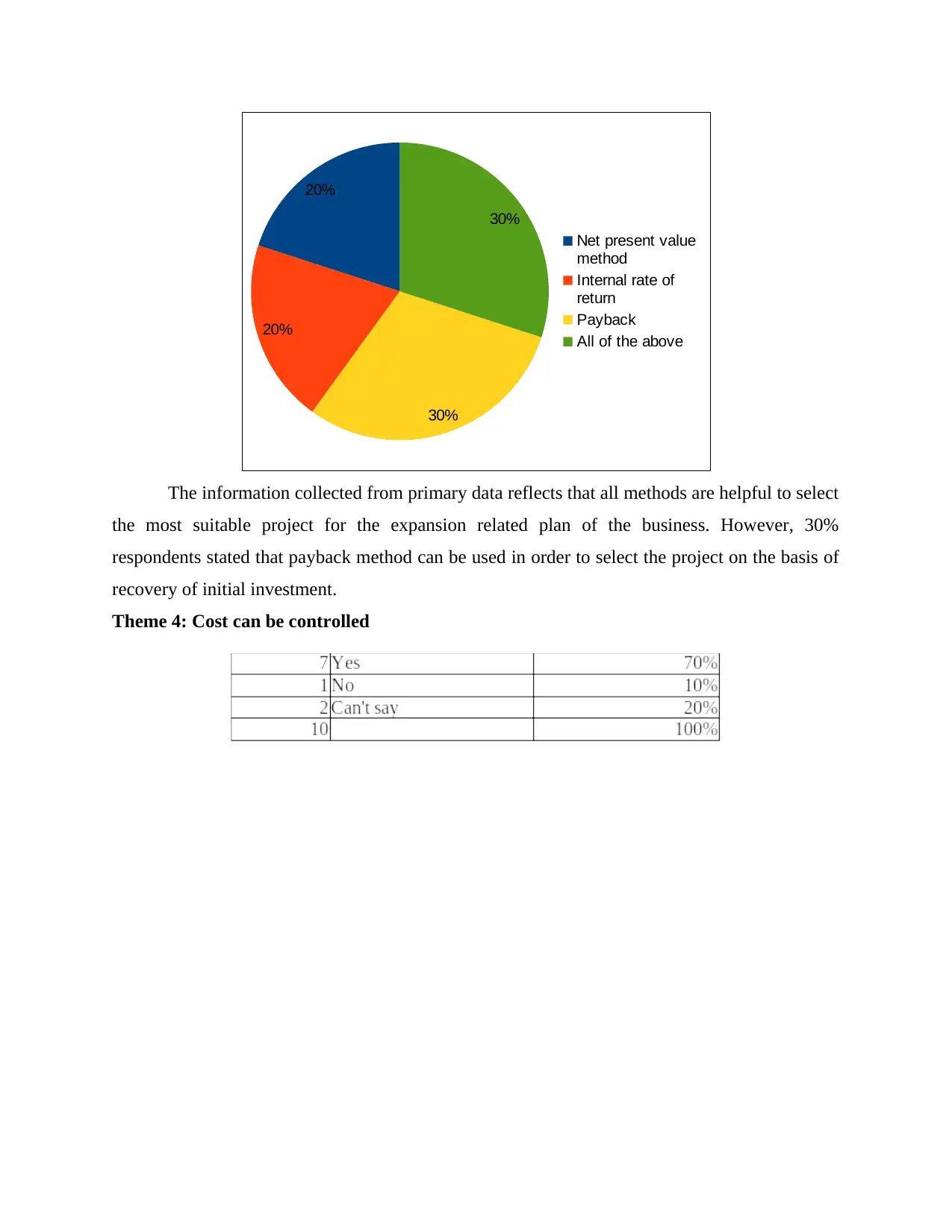
The information collected from primary data reflects that all methods are helpful to select
the most suitable project for the expansion related plan of the business. However, 30%
respondents stated that payback method can be used in order to select the project on the basis of
recovery of initial investment.
Theme 4: Cost can be controlled
20%
20%
30%
30%
Net present value
method
Internal rate of
return
Payback
All of the above
the most suitable project for the expansion related plan of the business. However, 30%
respondents stated that payback method can be used in order to select the project on the basis of
recovery of initial investment.
Theme 4: Cost can be controlled
20%
20%
30%
30%
Net present value
method
Internal rate of
return
Payback
All of the above
⊘ This is a preview!⊘
Do you want full access?
Subscribe today to unlock all pages.

Trusted by 1+ million students worldwide
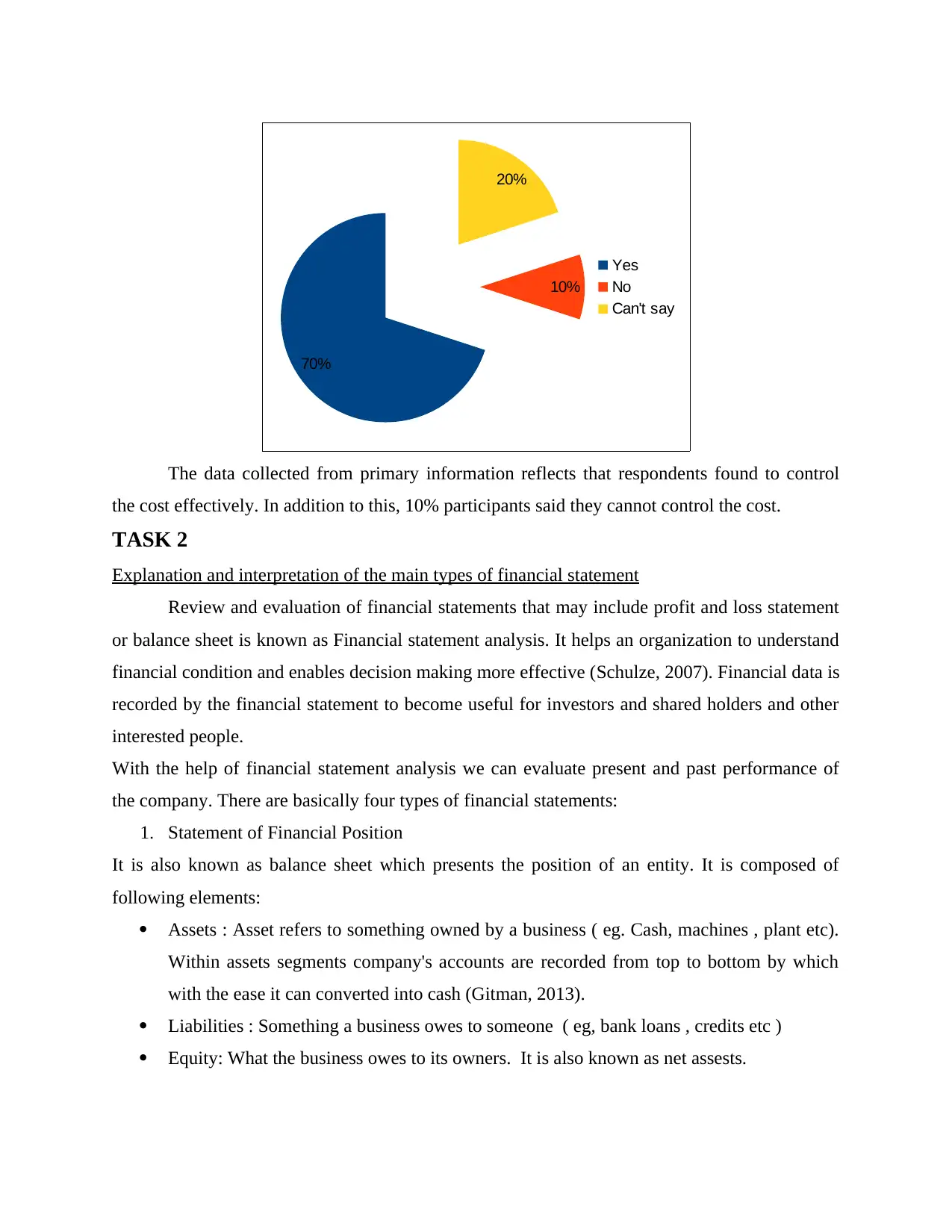
The data collected from primary information reflects that respondents found to control
the cost effectively. In addition to this, 10% participants said they cannot control the cost.
TASK 2
Explanation and interpretation of the main types of financial statement
Review and evaluation of financial statements that may include profit and loss statement
or balance sheet is known as Financial statement analysis. It helps an organization to understand
financial condition and enables decision making more effective (Schulze, 2007). Financial data is
recorded by the financial statement to become useful for investors and shared holders and other
interested people.
With the help of financial statement analysis we can evaluate present and past performance of
the company. There are basically four types of financial statements:
1. Statement of Financial Position
It is also known as balance sheet which presents the position of an entity. It is composed of
following elements:
Assets : Asset refers to something owned by a business ( eg. Cash, machines , plant etc).
Within assets segments company's accounts are recorded from top to bottom by which
with the ease it can converted into cash (Gitman, 2013).
Liabilities : Something a business owes to someone ( eg, bank loans , credits etc )
Equity: What the business owes to its owners. It is also known as net assests.
70%
10%
20%
Yes
No
Can't say
the cost effectively. In addition to this, 10% participants said they cannot control the cost.
TASK 2
Explanation and interpretation of the main types of financial statement
Review and evaluation of financial statements that may include profit and loss statement
or balance sheet is known as Financial statement analysis. It helps an organization to understand
financial condition and enables decision making more effective (Schulze, 2007). Financial data is
recorded by the financial statement to become useful for investors and shared holders and other
interested people.
With the help of financial statement analysis we can evaluate present and past performance of
the company. There are basically four types of financial statements:
1. Statement of Financial Position
It is also known as balance sheet which presents the position of an entity. It is composed of
following elements:
Assets : Asset refers to something owned by a business ( eg. Cash, machines , plant etc).
Within assets segments company's accounts are recorded from top to bottom by which
with the ease it can converted into cash (Gitman, 2013).
Liabilities : Something a business owes to someone ( eg, bank loans , credits etc )
Equity: What the business owes to its owners. It is also known as net assests.
70%
10%
20%
Yes
No
Can't say
Paraphrase This Document
Need a fresh take? Get an instant paraphrase of this document with our AI Paraphraser
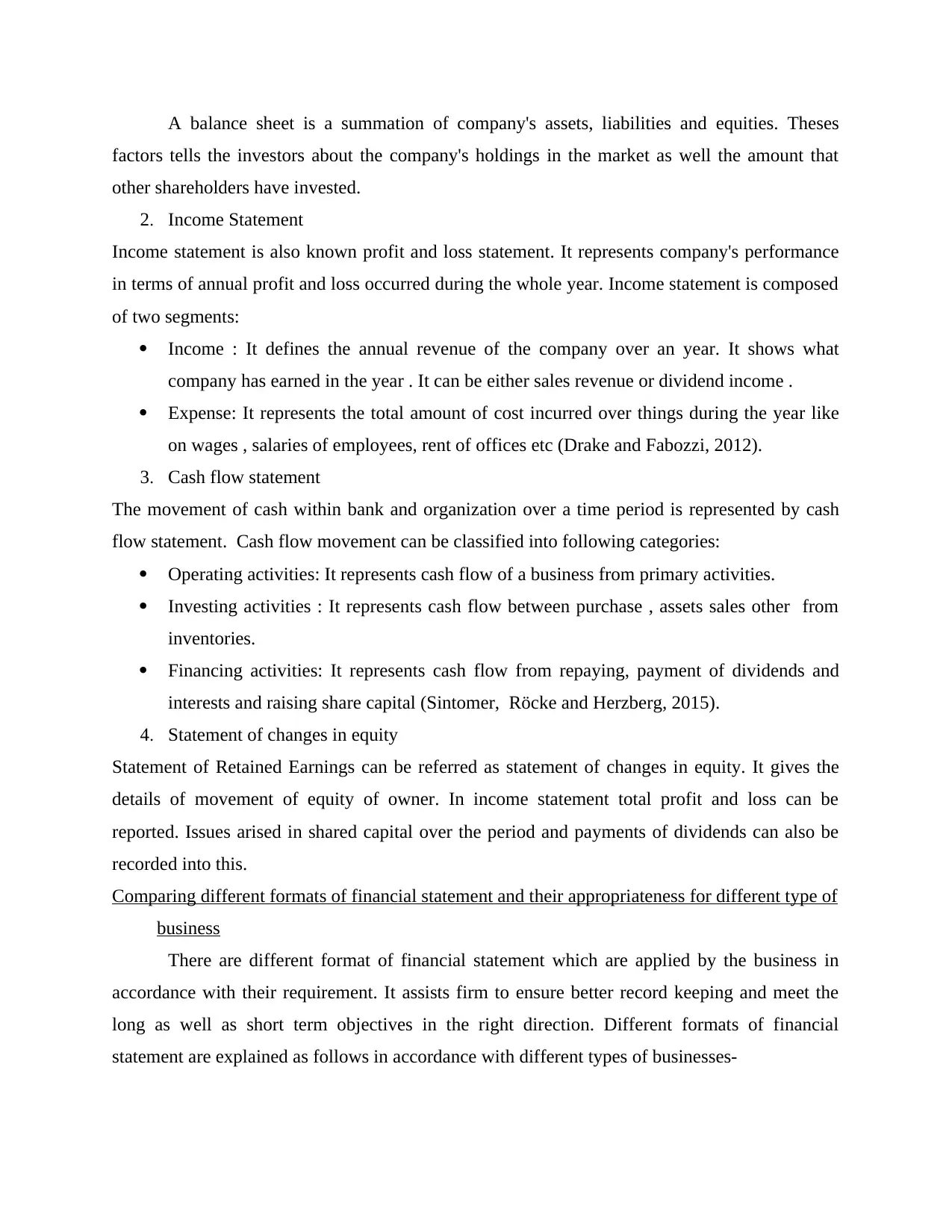
A balance sheet is a summation of company's assets, liabilities and equities. Theses
factors tells the investors about the company's holdings in the market as well the amount that
other shareholders have invested.
2. Income Statement
Income statement is also known profit and loss statement. It represents company's performance
in terms of annual profit and loss occurred during the whole year. Income statement is composed
of two segments:
Income : It defines the annual revenue of the company over an year. It shows what
company has earned in the year . It can be either sales revenue or dividend income .
Expense: It represents the total amount of cost incurred over things during the year like
on wages , salaries of employees, rent of offices etc (Drake and Fabozzi, 2012).
3. Cash flow statement
The movement of cash within bank and organization over a time period is represented by cash
flow statement. Cash flow movement can be classified into following categories:
Operating activities: It represents cash flow of a business from primary activities.
Investing activities : It represents cash flow between purchase , assets sales other from
inventories.
Financing activities: It represents cash flow from repaying, payment of dividends and
interests and raising share capital (Sintomer, Röcke and Herzberg, 2015).
4. Statement of changes in equity
Statement of Retained Earnings can be referred as statement of changes in equity. It gives the
details of movement of equity of owner. In income statement total profit and loss can be
reported. Issues arised in shared capital over the period and payments of dividends can also be
recorded into this.
Comparing different formats of financial statement and their appropriateness for different type of
business
There are different format of financial statement which are applied by the business in
accordance with their requirement. It assists firm to ensure better record keeping and meet the
long as well as short term objectives in the right direction. Different formats of financial
statement are explained as follows in accordance with different types of businesses-
factors tells the investors about the company's holdings in the market as well the amount that
other shareholders have invested.
2. Income Statement
Income statement is also known profit and loss statement. It represents company's performance
in terms of annual profit and loss occurred during the whole year. Income statement is composed
of two segments:
Income : It defines the annual revenue of the company over an year. It shows what
company has earned in the year . It can be either sales revenue or dividend income .
Expense: It represents the total amount of cost incurred over things during the year like
on wages , salaries of employees, rent of offices etc (Drake and Fabozzi, 2012).
3. Cash flow statement
The movement of cash within bank and organization over a time period is represented by cash
flow statement. Cash flow movement can be classified into following categories:
Operating activities: It represents cash flow of a business from primary activities.
Investing activities : It represents cash flow between purchase , assets sales other from
inventories.
Financing activities: It represents cash flow from repaying, payment of dividends and
interests and raising share capital (Sintomer, Röcke and Herzberg, 2015).
4. Statement of changes in equity
Statement of Retained Earnings can be referred as statement of changes in equity. It gives the
details of movement of equity of owner. In income statement total profit and loss can be
reported. Issues arised in shared capital over the period and payments of dividends can also be
recorded into this.
Comparing different formats of financial statement and their appropriateness for different type of
business
There are different format of financial statement which are applied by the business in
accordance with their requirement. It assists firm to ensure better record keeping and meet the
long as well as short term objectives in the right direction. Different formats of financial
statement are explained as follows in accordance with different types of businesses-
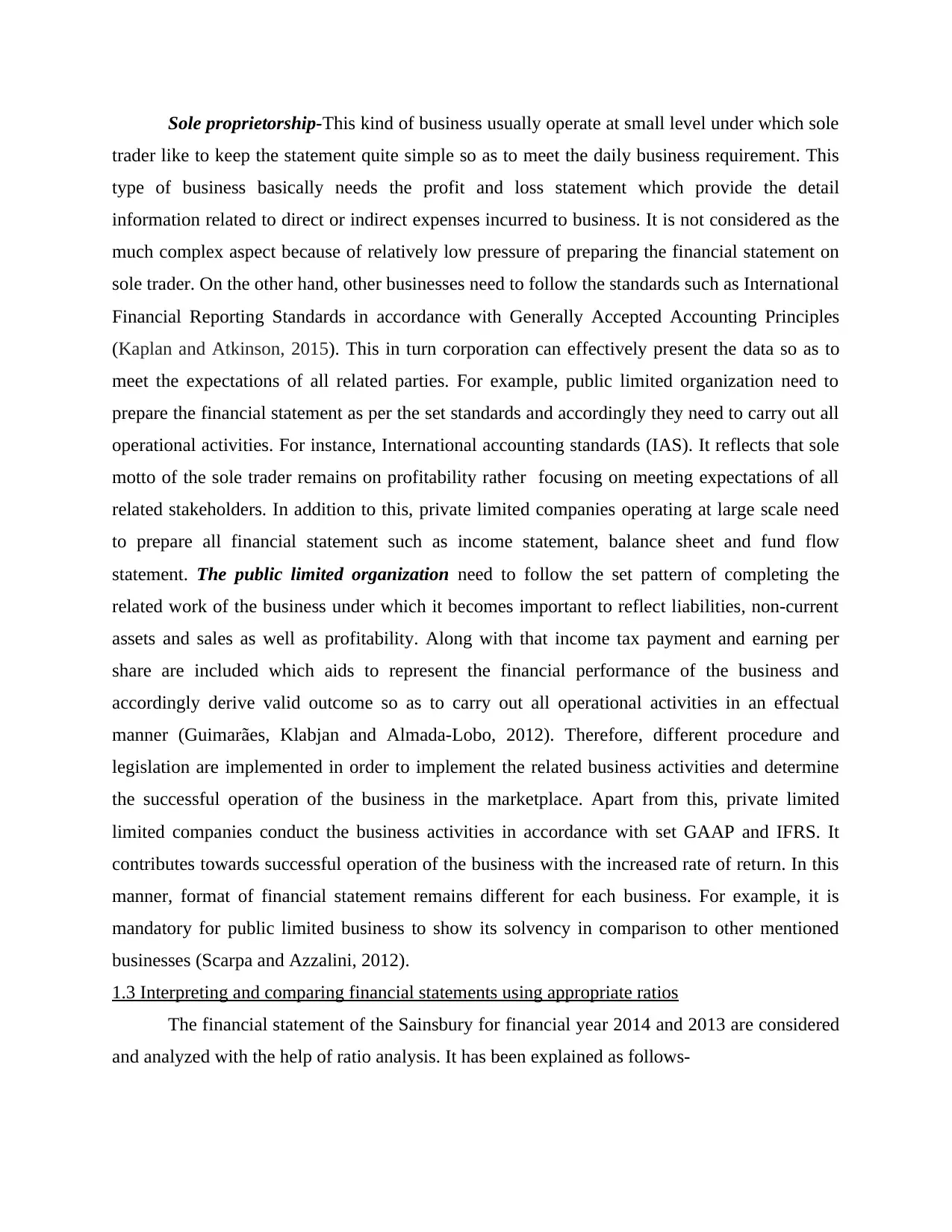
Sole proprietorship-This kind of business usually operate at small level under which sole
trader like to keep the statement quite simple so as to meet the daily business requirement. This
type of business basically needs the profit and loss statement which provide the detail
information related to direct or indirect expenses incurred to business. It is not considered as the
much complex aspect because of relatively low pressure of preparing the financial statement on
sole trader. On the other hand, other businesses need to follow the standards such as International
Financial Reporting Standards in accordance with Generally Accepted Accounting Principles
(Kaplan and Atkinson, 2015). This in turn corporation can effectively present the data so as to
meet the expectations of all related parties. For example, public limited organization need to
prepare the financial statement as per the set standards and accordingly they need to carry out all
operational activities. For instance, International accounting standards (IAS). It reflects that sole
motto of the sole trader remains on profitability rather focusing on meeting expectations of all
related stakeholders. In addition to this, private limited companies operating at large scale need
to prepare all financial statement such as income statement, balance sheet and fund flow
statement. The public limited organization need to follow the set pattern of completing the
related work of the business under which it becomes important to reflect liabilities, non-current
assets and sales as well as profitability. Along with that income tax payment and earning per
share are included which aids to represent the financial performance of the business and
accordingly derive valid outcome so as to carry out all operational activities in an effectual
manner (Guimarães, Klabjan and Almada-Lobo, 2012). Therefore, different procedure and
legislation are implemented in order to implement the related business activities and determine
the successful operation of the business in the marketplace. Apart from this, private limited
limited companies conduct the business activities in accordance with set GAAP and IFRS. It
contributes towards successful operation of the business with the increased rate of return. In this
manner, format of financial statement remains different for each business. For example, it is
mandatory for public limited business to show its solvency in comparison to other mentioned
businesses (Scarpa and Azzalini, 2012).
1.3 Interpreting and comparing financial statements using appropriate ratios
The financial statement of the Sainsbury for financial year 2014 and 2013 are considered
and analyzed with the help of ratio analysis. It has been explained as follows-
trader like to keep the statement quite simple so as to meet the daily business requirement. This
type of business basically needs the profit and loss statement which provide the detail
information related to direct or indirect expenses incurred to business. It is not considered as the
much complex aspect because of relatively low pressure of preparing the financial statement on
sole trader. On the other hand, other businesses need to follow the standards such as International
Financial Reporting Standards in accordance with Generally Accepted Accounting Principles
(Kaplan and Atkinson, 2015). This in turn corporation can effectively present the data so as to
meet the expectations of all related parties. For example, public limited organization need to
prepare the financial statement as per the set standards and accordingly they need to carry out all
operational activities. For instance, International accounting standards (IAS). It reflects that sole
motto of the sole trader remains on profitability rather focusing on meeting expectations of all
related stakeholders. In addition to this, private limited companies operating at large scale need
to prepare all financial statement such as income statement, balance sheet and fund flow
statement. The public limited organization need to follow the set pattern of completing the
related work of the business under which it becomes important to reflect liabilities, non-current
assets and sales as well as profitability. Along with that income tax payment and earning per
share are included which aids to represent the financial performance of the business and
accordingly derive valid outcome so as to carry out all operational activities in an effectual
manner (Guimarães, Klabjan and Almada-Lobo, 2012). Therefore, different procedure and
legislation are implemented in order to implement the related business activities and determine
the successful operation of the business in the marketplace. Apart from this, private limited
limited companies conduct the business activities in accordance with set GAAP and IFRS. It
contributes towards successful operation of the business with the increased rate of return. In this
manner, format of financial statement remains different for each business. For example, it is
mandatory for public limited business to show its solvency in comparison to other mentioned
businesses (Scarpa and Azzalini, 2012).
1.3 Interpreting and comparing financial statements using appropriate ratios
The financial statement of the Sainsbury for financial year 2014 and 2013 are considered
and analyzed with the help of ratio analysis. It has been explained as follows-
⊘ This is a preview!⊘
Do you want full access?
Subscribe today to unlock all pages.

Trusted by 1+ million students worldwide
1 out of 24
Related Documents
Your All-in-One AI-Powered Toolkit for Academic Success.
+13062052269
info@desklib.com
Available 24*7 on WhatsApp / Email
![[object Object]](/_next/static/media/star-bottom.7253800d.svg)
Unlock your academic potential
Copyright © 2020–2025 A2Z Services. All Rights Reserved. Developed and managed by ZUCOL.





